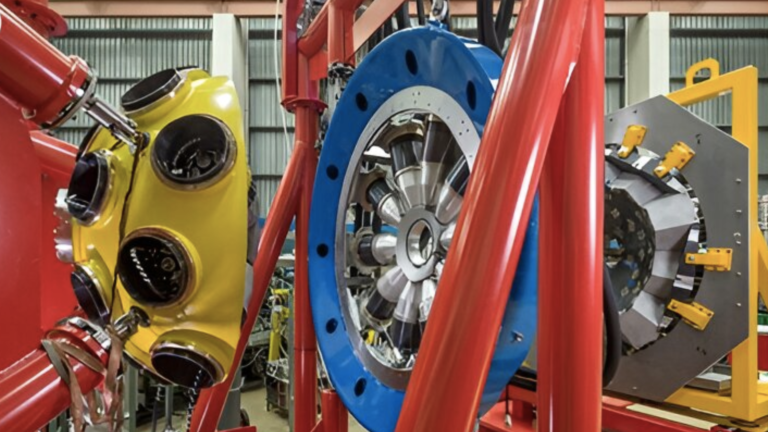
Image of the test setup for the heat shield. Credit: (2023). DOI: 10.2172/1960159
NASA is very interested in developing a propulsion method to allow spacecraft to go faster. We’ve reported several times on various ideas to support this goal, and most of the most successful ones have made good use of the sun’s gravity, usually by throwing slingshots around it, as Jupiter currently does.
But there are still significant hurdles when doing this, not the least of which is the energy radiating from the sun simply vaporizing anything that gets close enough to use a gravity assist. That’s the problem a project supported by NASA’s Institute for Advanced Concepts (NIAC) and led by Jason Benkoski, now of Lawrence Livermore National Laboratory, is trying to solve.
The project was awarded a Phase I NIAC grant in 2022, focused on combining two separate systems – a thermal shield and a thermal propulsion system. According to the project’s final report, the combination of these two technologies could allow a spacecraft to perform what is known as an Oberth maneuver around the sun.
In this trick of orbital mechanics, a spacecraft makes good use of the sun’s gravity to launch high-speed rockets in its intended direction. It is similar to the Sundiver technology discussed in other articles.
So what makes this project unique? One thing is the heat shield – Dr. Benkoski and his team developed a material that is capable of withstanding up to 2700 K. While this is still nowhere near the surface temperature of the sun, which can reach up to 5800 K, it is enough to get very close and to unlock a spacecraft ability to use an Oberth maneuver in the first place.
Samples of material with these thermal properties have already been produced. However, further research is needed to understand if they are cut out for space flight. And a heat shield alone isn’t enough to perform the maneuver—a spacecraft also needs to have a propulsion system that can withstand those temperatures.
A solar thermal propulsion system could potentially do this. These systems use the sun’s energy to pressurize their propellant and then eject those propellants outward to gain thrust, which is a necessary component of an Oberth maneuver. There are several different types of fuels that could work for such a system, and much of the research in the Phase I project looked at the various costs/benefits of each.
Hydrogen is one of the most common fuels considered for a solar thermal propulsion system. Although it is light, it requires a heavy cryogenic system to store the hydrogen because it is heated to the point of being used as propellant. In the end, its trade-offs made it the least effective of the drivers considered during the project.
Lithium hydride was the surprise winner for the fuel that allows for the fastest escape velocity. Calculations show that it could result in a speed of over 12 AU/year. However, there are limitations with fuel storage and handling.
Dr. Benkoski settled on a more common fuel as the overall winner of the modeling he did – methane. While it generally results in a slower terminal velocity than lithium hydride, its terminal velocity is still respectable at over 10 AU/year. It also eliminates much of the trouble of storing other propellants, such as the cryogenics needed to store hydrogen.
However, there are some drawbacks – the calculated top speed is only about 1.7 times faster than what could already be done with a gravitational assist from Jupiter, which wouldn’t require all the fancy thermal shielding.
However, there are other weaknesses, such as the direction in which the spacecraft can travel being limited by where Jupiter is in relation to other objects of interest. On the other hand, by orbiting the sun, it is possible to reach almost anywhere in the solar system and beyond with the right controlled burn.
As stated by Dr. Benkoski in the final report, he made many assumptions when making his modeling calculations, including that the system would only be able to use already developed technologies and not speculative ones that could dramatically affect the results.
Right now, it does not appear that NASA has selected this project to move into Phase II, and it is unclear what future work is planned for further development. If nothing else, it’s a step toward understanding what it would take to actually send spacecraft past the sun and into deep space at a much faster speed than anything that’s gone before. Given NASA’s continued attention to the subject, surely one day one of the missions will succeed in doing so.
More information:
Jason Benkoski et al, Combined Heat Shield and Solar Thermal Propulsion System for an Oberth Maneuver (2023). DOI: 10.2172/1960159
Provided by Universe Today
citation: Slingshotting Sun Spacecraft Would Make Spacecraft Fastest Ever (2024, June 21) Retrieved June 22, 2024 from https://phys.org/news/2024-06-slingshotting-sun-spacecraft-fastest. html
This document is subject to copyright. Except for any fair agreement for study or private research purposes, no part may be reproduced without written permission. The content is provided for informational purposes only.




